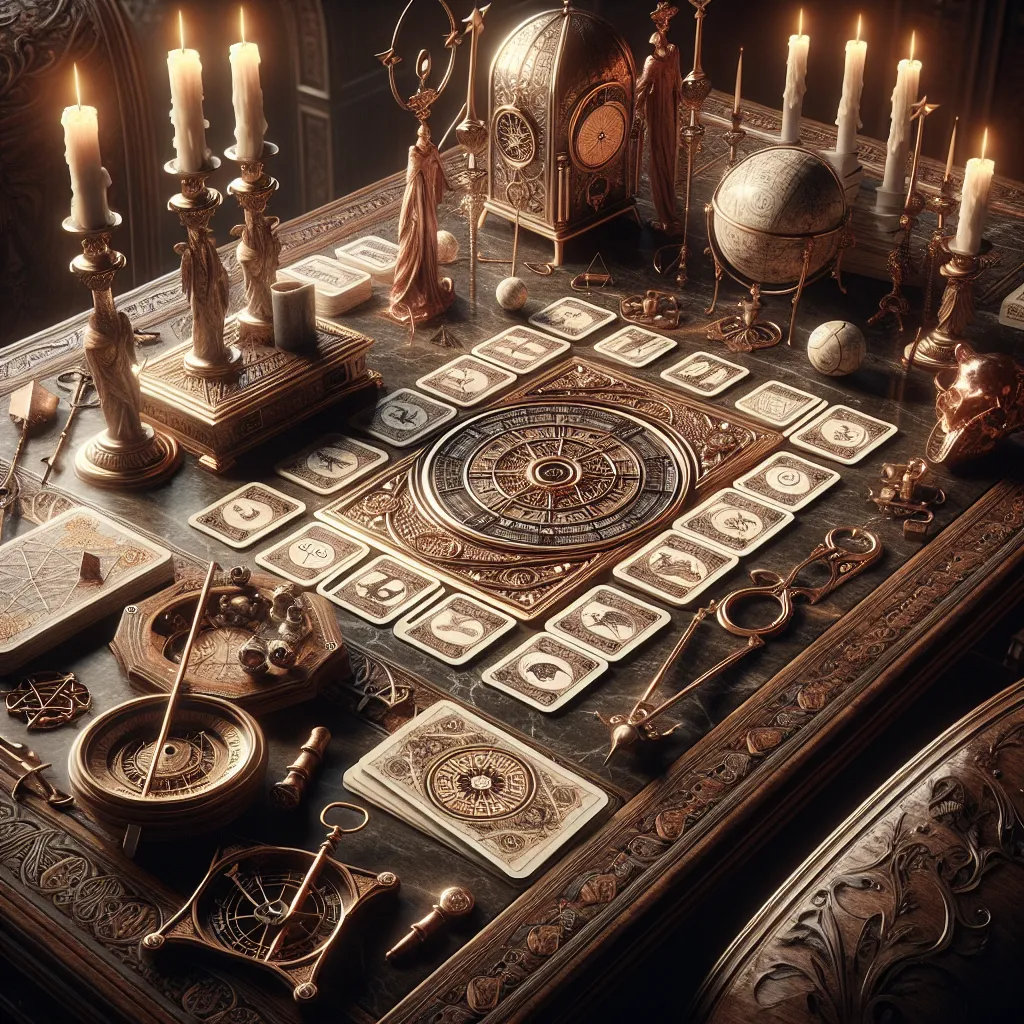
- Published on
- Authors

- Name
- You
Hermeticism and the Tarot: Symbolism and Divination
Table of Contents
- [Introduction](#i ntroduction)
- [Hermeticism: An Overview](#h ermeticism-an-overview)
- [The Tarot: A Brief History](#t he-tarot-a-brief-history)
- [Symbolism in the Tarot](#s ymbolism-in-the-tarot)
- 4.1 [Major Arcana](#m ajor-arcana)
- 4.2 [Minor Arcana](#m inor-arcana)
- [Divination and the Tarot](#d ivination-and-the-tarot)
- [Conclusion](#c onclusion)
- [Further Reading](#f urther-reading)
Introduction
Imagine a journey through the very fabric of reality where each card drawn reveals secrets of the universe, the psyche, and the soul. The Tarot, with its vivid imagery and profound symbolism, is more than a deck for fortune-telling—it’s a metaphysical text, steeped in the rich tradition of Hermeticism. By merging the wisdom of Hermetic principles with the mystical archetypes found in Tarot cards, we embark on an enlightening exploration that bridges ancient knowledge with our contemporary quest for spiritual insight.
Hermeticism: An Overview
Rooted in the teachings attributed to Hermes Trismegistus, a mythical figure combining elements of the Greek god Hermes and the Egyptian god Thoth, Hermeticism is a philosophical and esoteric tradition. Its doctrines are encapsulated in the "Hermetic Corpus" and revolve around:
- The Principle of Mentalism: "The All is Mind; the Universe is Mental."
- The Principle of Correspondence: "As above, so below; as below, so above."
- The Principle of Vibration: "Nothing rests; everything moves; everything vibrates."
- The Principle of Polarity: "Everything is dual; everything has poles."
- The Principle of Rhythm: "Everything flows, out and in."
- The Principle of Cause and Effect: "Every cause has its effect; every effect has its cause."
- The Principle of Gender: "Gender is in everything; everything has its Masculine and Feminine principles."
The Tarot: A Brief History
The Tarot as we know it today likely began as a deck of playing cards in 15th-century Europe. However, its modern use as a tool for divination and introspection didn’t crystallize until the 18th century, when occultists like Antoine Court de Gébelin speculated on its ancient Egyptian origins and mystical significance. The Tarot deck comprises 78 cards divided into:
- Major Arcana (22 cards)
- Minor Arcana (56 cards, divided into four suits)
Symbolism in the Tarot
Major Arcana
The Major Arcana represents life’s karmic and spiritual lessons. These 22 cards are laden with deep archetypal meanings that correspond to the journey of the soul towards enlightenment.
| Card | Hermetic Symbolism |
|---|---|
| The Fool | The beginning; potential; innocence; corresponds to pure spirit. |
| The Magician | Manifestation; willpower; as above, so below (The Principle of Correspondence). |
| The High Priestess | Intuition; the subconscious; the marriage of wisdom and mystery. |
| The Empress | Fertility; creation; the embodiment of Mother Nature. |
| The Emperor | Authority; structure; the paternal archetype. |
| The Hierophant | Tradition; spiritual guidance; the link between divine and earthly knowledge. |
| The Lovers | Union; choice; the divine harmony between opposites. |
Minor Arcana
The Minor Arcana reflects the trials and tribulations encountered daily, offering insight into situations and emotional states through four suits:
- Wands (Fire): Energy, inspiration, spirituality.
- Cups (Water): Emotions, relationships, intuition.
- Swords (Air): Intellect, conflict, change.
- Pentacles (Earth): Material aspects, career, body.
Divination and the Tarot
Divination through the Tarot involves more than predicting the future; it’s a reflective exercise that can guide one’s spiritual journey. When reading the Tarot, one taps into the collective unconscious—a Jungian concept parallel to Hermetic ideas of universal mind.
Sample Spread: The Hermetic Cross
- Past: Reflects the influences that have shaped your current situation.
- Present: Represents your current state or dilemma.
- Future: Indicates potential outcomes based on current trajectories.
- Above: Symbolizes divine guidance or higher principles at play.
- Below: Denotes underlying issues or foundational supports.
Conclusion
Hermeticism and the Tarot weave together a tapestry of metaphysical and mystical wisdom. By exploring the archetypal symbols and principles that guide our understanding of the universe, we delve into a timeless journey toward self-awareness and enlightenment. As we draw each card, we are reminded that the answers we seek lie both within and in the harmonious dance of the cosmos.
Further Reading
- Hermetica: The Greek Corpus Hermeticum and the Latin Asclepius by Brian P. Copenhaver
- The Tarot: History, Symbolism, and Divination by Robert M. Place
- The Kybalion by Three Initiates
Embark on this journey, dear seeker, for within the mysteries of the Tarot and the tenets of Hermeticism lies a treasure trove of wisdom waiting to be discovered.
Engage with the enigmatic dance between symbols and your spirit—let each card drawn paint a pathway to the stars!
